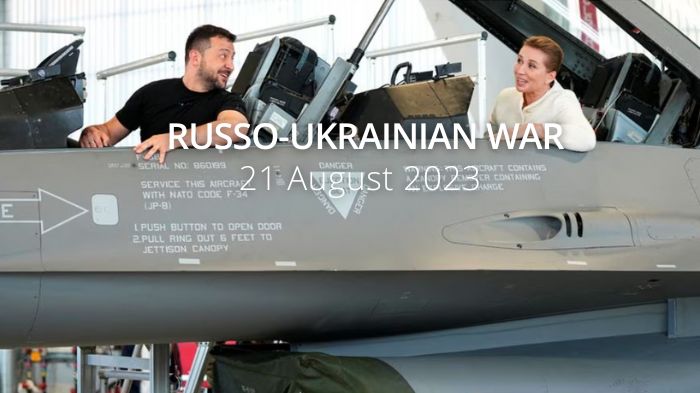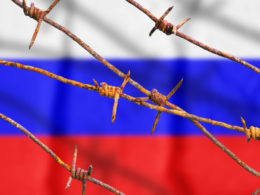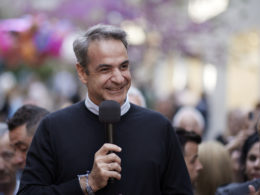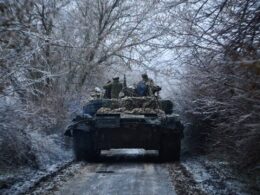Zelenskyy: Ukraine to receive 42 F-16 fighter jets. Ukrainian drones attack Kursk, Rostov and Belgorod regions in Russia. Ukraine changes its counteroffensive approach.
Morning report day 544 – August 21
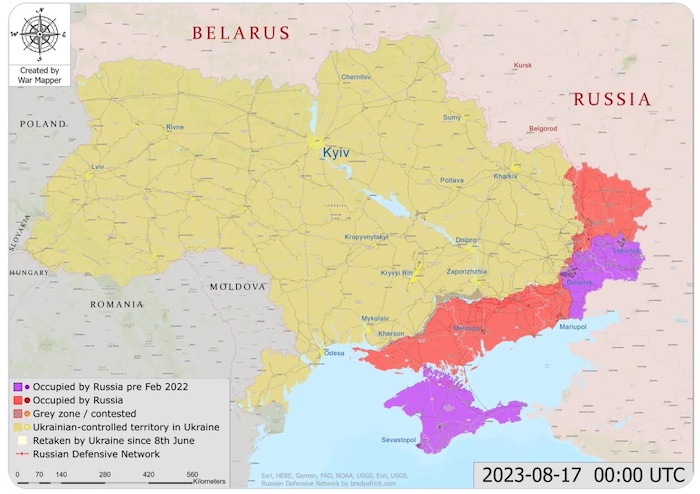
According to information from the General Staff as of 06.00 21.08.2023, supplemented by its [18:00 assessment].

“On August 20, the enemy launched 29 airstrikes and 43 MLRS attacks at the positions of Ukrainian troops and various settlements. Unfortunately, the Russian terrorist attacks have killed and wounded civilians. Residential buildings, a building of an educational institution and other civilian infrastructure were damaged.
The likelihood of missiles and airstrikes across Ukraine remains high.
On August 20, there were more than 25 combat engagements.
- Volyn and Polissya axes: no significant changes.
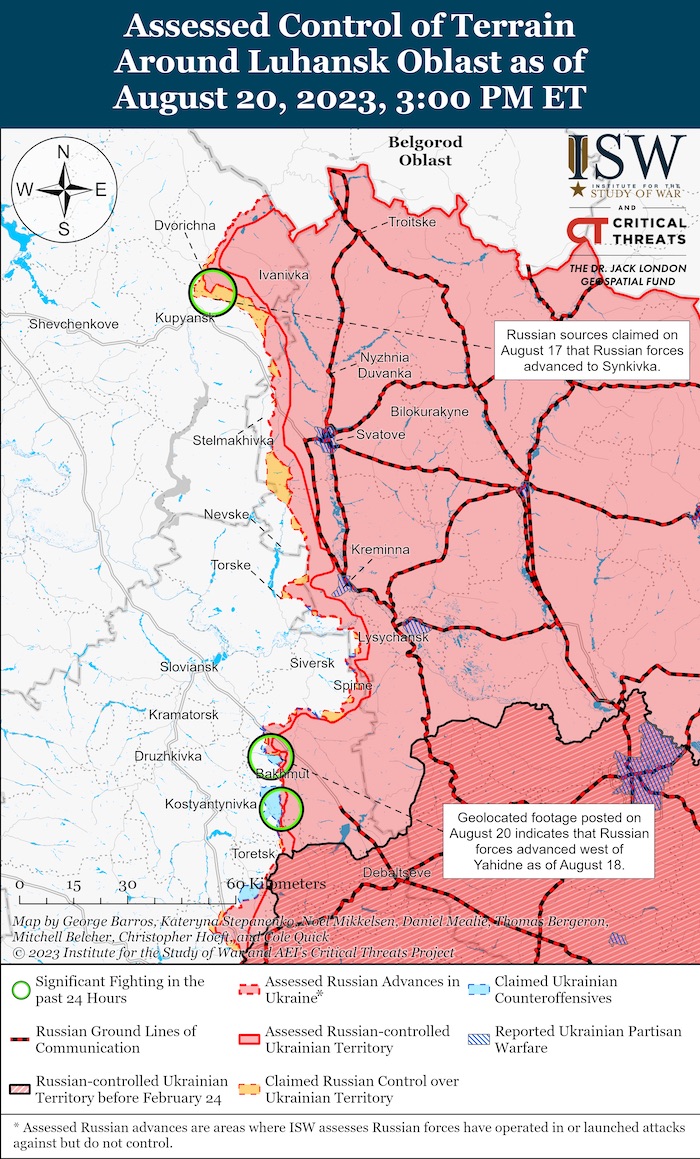
- Sivershchyna and Slobozhanshchyna axes: the adversary launched airstrikes in the areas southwest of Iskryskivshchyna and Zhuravka (Sumy oblast). The enemy fired mortars and artillery at more than 30 settlements, including Karpovychi, Bohdanove (Chernihiv oblast), Tovstodubove, Volfyne, Pokrovka, Novooleksandrivka (Sumy oblast), Varvarivka, Budarky, Zemlyanky, and Komisarove (Kharkiv oblast).
- Kupiansk axis: the adversary launched an airstrike west of Mykolaivka. The invaders conducted unsuccessful offensive operations in the vicinity of Syn’kivka (Kharkiv oblast). The following settlements were shelled with artillery and mortars: Topoli, Masyutivka, Kup’yans’k, Kyslivka, and Berestove (Kharkiv oblast).
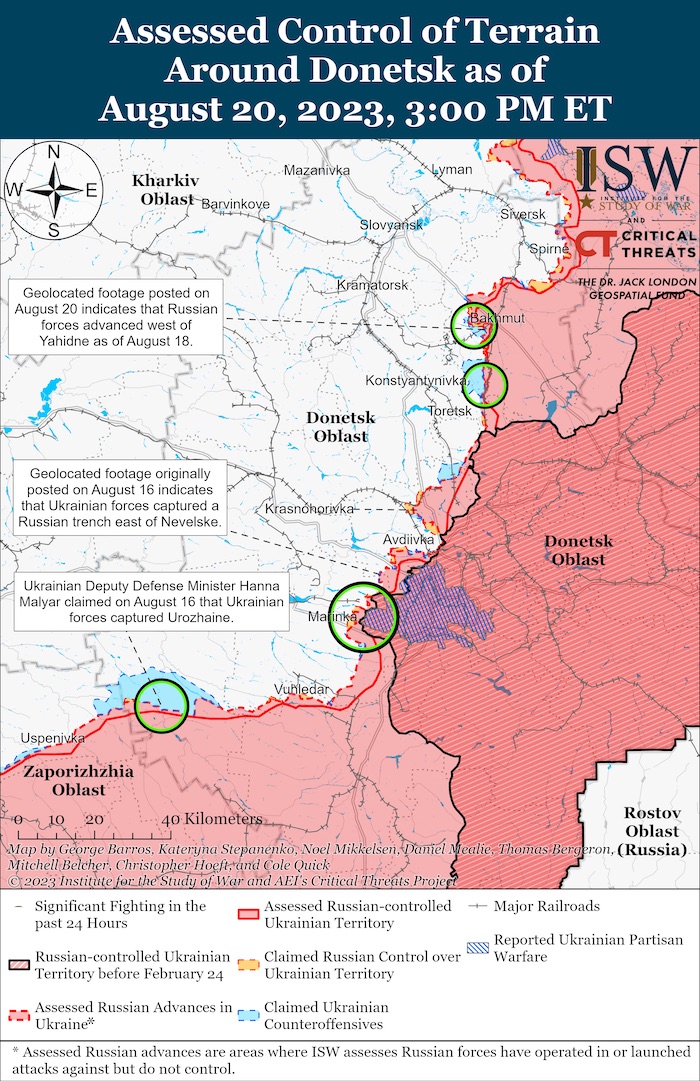
- Lyman axis: the enemy launched airstrikes in the vicinities of Shyikivka, Terny, Pyskunivka, and Vesele (Donetsk oblast). About 15 settlements, including Nevske, Bilohorivka (Luhansk oblast), Verkhn’okam’yans’ke, Tors’ke, and Spirne (Donetsk oblast), were shelled with artillery.

- Bakhmut axis: the adversary conducted unsuccessful offensives in the vicinity of Kurdyumivka (Donetsk oblast). The invaders launched airstrikes in the vicinities of Vesele, Klishchiivka, and Kurdyumivka (Donetsk oblast). More than 20 settlements, including Predtechyne, Dyliivka, Kurdyumivka, Ozarianivka, and Druzhba (Donetsk oblast), suffered from enemy artillery shelling.
- Avdiivka axis: the settlements of Keramik, Stepove, Orlivka, Avdiivka, Nevel’s’ke, and Karlivka (Donetsk oblast) came under artillery fire.
- Marinka axis: the Ukrainian Defense Forces continue to hold back the Russian offensive in the vicinity of Marinka (Donetsk oblast). The enemy launched airstrikes in the vicinities of Krasnohorivka and Novomykhailivka (Donetsk oblast). The settlements of Krasnohorivka, Mar’inka, Pobjeda, Oleksandropil’, Paraskoviivka, and Yelyzavetivka (Donetsk oblast) were shelled by the artillery.
- Shakhtarske axis: the enemy launched airstrikes in the vicinities of Vuhledar and Staromaiors’ke (Donetsk oblast). Vodyane, Vuhledar, Prechystivka, Zolota Nyva, Blahodatne, and Urozhaine (Donetsk oblast) were shelled with artillery.
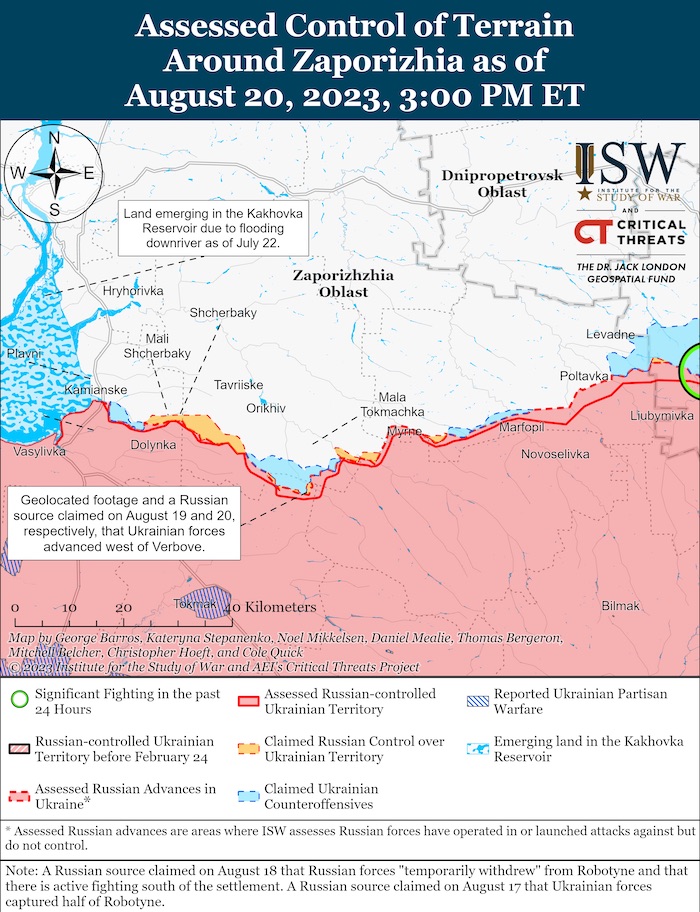
- Zaporizhzhia axis: the adversary launched airstrikes in the vicinities of Charivne, Robotyne, and Pavlivka (Zaporizhzhia oblast). More than 30 settlements suffered from enemy artillery shelling, including Novodarivka, Chervona Krynytsya, Mala Tokmachka, Mali Shcherbaky, Stepove, and P’yatykhatky (Zaporizhzhia oblast).
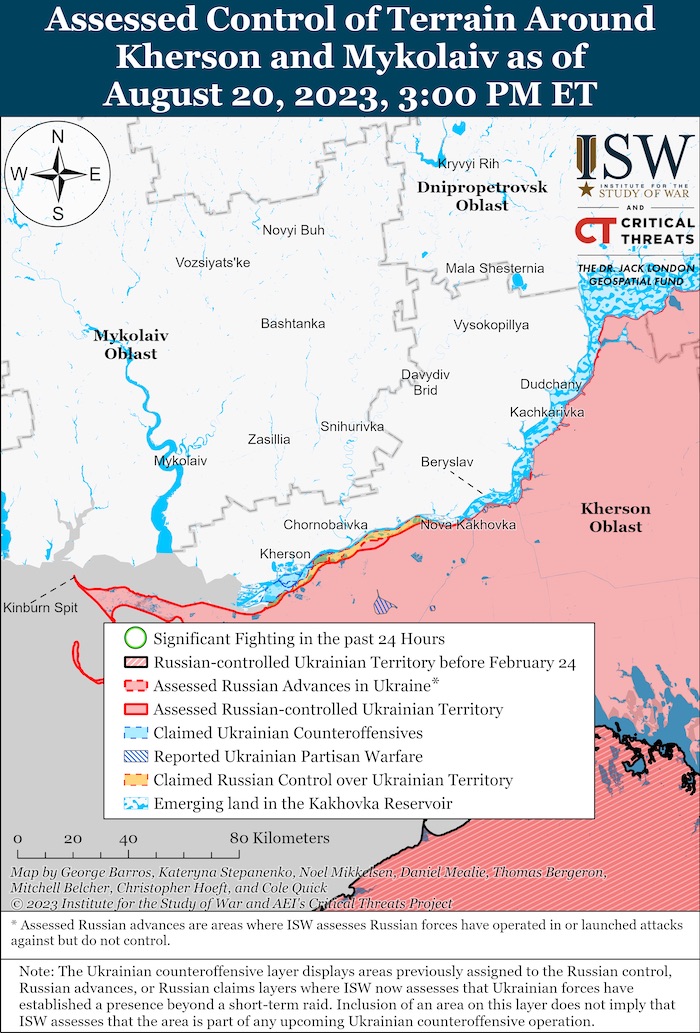
- Kherson axis: the adversary launched airstrikes in the vicinities of Ol’hivka and Sadove (Kherson oblast). More than 20 settlements suffered from enemy artillery shelling, including Zolota Balka, Kozats’ke, Tokarivka, Ponyativka, Kherson, Veletens’ke, and Kizomys (Kherson oblast).
Military Updates
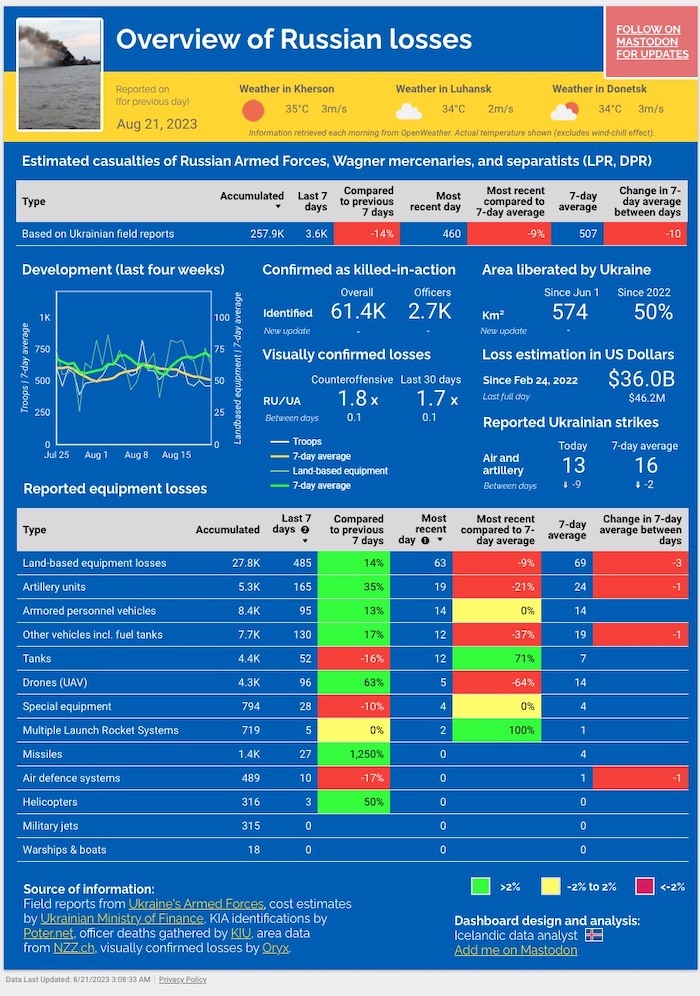
At the same time, the Ukrainian Defence Forces continue to conduct the offensive operation on Melitopol’ and Berdyans’k axes, consolidating their positions, and conducting counter-battery fire.
On August 20, the Ukrainian Air Force launched 9 airstrikes on the concentrations of the adversary troops.
On August 20, the Ukrainian missile and artillery troops hit 1 enemy command post and 3 artillery systems at their firing positions.“
Over the last day, Russians lost 232 soldiers, 27 units of equipment and 6 warehouses in the Tauria direction, Censor.net reports. “Oleksandr Tarnavsky, the commander of the operational-strategic grouping of the "Tauria" troops, announced the results of combat operations over the past day. The work of the Defence Forces continues in the Tauria direction. In general, during the past day, the enemy attacked our positions 16 times and carried out 626 shellings, carried out 15 airstrikes.
Artillery units of the Defense Forces of the Tauria direction performed 1,248 fire missions during the day. Over the last day, the enemy lost 232 people killed, wounded and captured (79 killed, 153 wounded). 27 units of enemy military equipment were destroyed. In particular, 6 tanks, 8 artillery systems and mortars, 1 anti-aircraft missile system, 1 ATGM, 1 LNG, 1 unmanned aerial vehicle, 2 units of automobiles and 1 unit of special equipment. 6 ammunition warehouses and 1 command and observation post were also destroyed."
Russian media published photo of Tu-22M3 bomber engulfed in fire at airfield of Russian Federation, Censor.net reports. “Today, 20 August, Russian public media began to publish photos allegedly showing the aftermath of yesterday’s drone attack on the military airfield in Soltsy, Novgorod region of Russia. The photo shows a Tu-22M3 bomber on fire. The photo shows that the plane was engulfed in flames and black smoke was rising above it.
It is alleged that the plane was based at the Soltsy airfield in Novgorod region, which was attacked by drones yesterday. A total of two aircraft were reportedly hit. One was less damaged, the other burned down completely. Yesterday, on 19 August, the Russian Ministry of Defence announced that a Ukrainian UAV had attacked a military airfield in the Novgorod region.” [About 700 km from Ukraine]
Russian authorities announced drone attack on Kursk, Censor.net reports, citing Russian Telegram channels. “On the night of 20 August, an explosion occurred near the railway station in Kursk. Russian authorities claimed a drone attack. An unidentified drone hit the roof of a railway station building. Russian authorities blamed Ukraine.
An attack by a Ukrainian drone in Kursk. According to preliminary information, it crashed into the roof of the railway station building, after which a fire broke out on the roof," said the Governor of the Kursk region, Roman Starovoit.”
Russia says Ukrainian drones attack four regions, Reuters reports. “Russia said Ukrainian drones had attacked four separate regions in a flurry of attempted strikes on Sunday, injuring five people and forcing two of Moscow's airports to briefly divert flights. Russia's Kursk, Rostov and Belgorod regions, all of which border Ukraine, reported attempted drone strikes, while Russia's defence ministry said it had jammed a Ukrainian drone in the Moscow region, forcing it to crash in an unpopulated area. […]
Later on Sunday, Russia's Defence Ministry said it had prevented two separate drone strikes on the Belgorod region, the border province most regularly attacked by Ukraine. The local governor said on Telegram that 12 airborne targets had been downed on the approaches to Belgorod city, before later saying only three drones had been shot down.
Ukrainian drone strikes both on border regions and on the Russian capital have become increasingly common in recent months, with repeated strikes on Moscow's financial district. […] Ukraine typically does not comment on who is behind attacks on Russian territory, although officials have publicly expressed satisfaction over them.”
On the night of August 19, 2023, the Rushists attacked from the north with "Shahed-136/131" attack UAVs, the Ukrainian General Staff reports. “A total of 17 attack drones were launched from the Kursk region. Anti-aircraft defence worked in the northern and central, as well as in the western regions. The forces and means of the Air Force in cooperation with the air defence of other components of the Defence Forces of Ukraine destroyed 15 enemy drones.
Over the past day, August 18, 2023, the air defence managed to destroy six unmanned aerial vehicles of operational-tactical level of various types and one attack type "Lancet".”
According to British Defence Intelligence, (last 48 hours):

- Russia is expanding its military structures in the face of wartime realities. One new formation is highly likely – the 18th Combined Arms Army (18 CAA).
- The formation is likely to be an amalgamation and uplift of other units currently operating in Kherson Oblast, including 22nd Army Corps, the force which usually constitutes Russia’s garrison in occupied Crimea.
- 18 CAA is likely to consist mostly of mobilised personnel and to focus on defensive security operations in the south of Ukraine. Russia likely aims to free up more experienced units to fight on key axes. There is a realistic possibility that this has led to the recent re-deployment of airborne forces from Kherson to the heavily contested Orikhiv sector.
- The leadership of Russia’s Aerospace Forces (VKS) is highly likely under intense pressure to improve air defences over western Russia. In recent months, the range of threats penetrating well inside Russia has increased. Strikes deep inside Russia are strategically important because President Putin almost certainly invaded Ukraine on the assumption that it would have little direct effect on Russians.
- Uncrewed Aerial Vehicles are regularly hitting Moscow. In addition, there have also been increasing reports of SA-5 GAMMON missiles striking Russia. This Soviet-era 7.5 tonne, 11-metre long weapon is retired from its air defence role in Ukraine’s inventory. However, it is now apparently being employed as a ground attack ballistic missile.
- Pressure is likely to particularly fall on VKS Chief of Staff, Colonel-General Viktor Afzalov; VKS Commander-in-Chief General Sergei Surovikin remains absent, suspected to have been detained in relation to the June 2023 Wagner Group mutiny..
Losses of the Russian Army
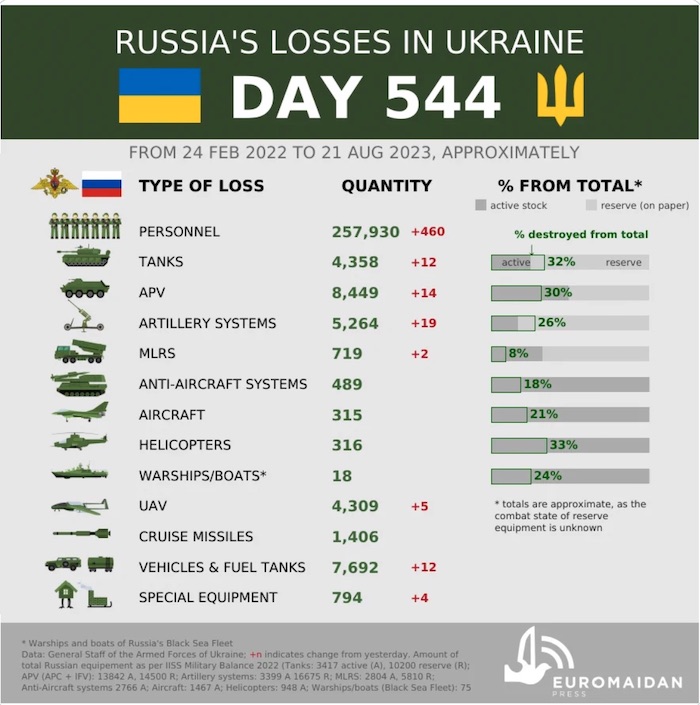
As of Monday 21 August, the approximate losses of weapons and military equipment of the Russian Armed Forces from the beginning of the invasion to the present day:
- Personnel – about 257930 (+460)
- Tanks – 4358 (+12)
- Armoured combat vehicles – 8449 (+14)
- Artillery systems – 5264 (+19)
- Multiple rocket launchers –MLRS - 719 (+2)
- Air defence means – 489 (+0)
- Aircraft - 315 (+0)
- Helicopters - 316 (+0)
- Automotive technology and fuel tanks – 7692 (+12)
- Vessels/boats - 18 (+0)
- UAV operational and tactical level – 4309 (+5)
- Special equipment – 794 (+4)
- Mobile SRBM system – 4 (+0)
- Cruise missiles – 1406 (+0)
Russians have already fired more than 6,500 missiles across Ukraine, Ukrinform reports. “Since the beginning of the full-scale invasion, the Russian Federation has already fired more than 6,500 missiles and launched 3,500 drones at Ukraine. President Volodymyr Zelensky stated this at a joint press conference with Prime Minister of the Netherlands Mark Rutte. […] The president emphasized that the majority of strikes were launched on civilian facilities, not military ones.”
China assists Russia with military build-up by supplying helicopters and metals for bombers, Ukrainska Pravda reports, citing The Telegraph. “Since the start of the Russian full-scale invasion of Ukraine, China has completed thousands of deliveries to Russian companies – including those under sanctions – producing missile launchers, armoured vehicles and strategic bombers. Russian companies producing missile launchers, armoured vehicles and strategic bombers reportedly received tens of thousands of shipments from China starting from the beginning of Russia's full-scale invasion of Ukraine until the first quarter of this year.
Trade between China and Russia is expected to exceed US$200 billion this year, setting a new record, given that Chinese exports to other countries have fallen significantly. In most cases, the Chinese goods exported to Russia are labelled as dual-use, allowing China to circumvent international sanctions and claim to be engaged in legitimate trade with Russia.
A Chinese company sent 1,000 drones to Russia two months before the war, says Molfar Global. The Chinese company Hems999 delivered two helicopters four days after the start of the Russian full-scale war against Ukraine. Another Chinese company, Tianjin Huarong Aviation, has supplied four Airbus helicopters to Russia since the beginning of the full-scale war.
Chinese firms also sent optical sights to over 50 Russian companies. Imports of these goods almost doubled to US$2.5 million last year compared to the previous one. The invoices indicated that the equipment was intended for "hunting".
Furthermore, China supplied Russia with turbojet engines and radar missile and navigation systems through India and Costa Rica. China exported titanium alloy products to Russia in 2022, a key material for producing military aircraft and weapons. Chinese companies have also sent supplies of magnesium alloys to Tupolev, a company involved in building and maintaining long-range bombers such as the Tu-95 and Tu-160M used in cruise missile strikes on Ukraine.”
Humanitarian
European Commission plans to subsidize export of Ukrainian grain, Censor.net reports, citing Bloomberg, with reference to Polish Public Radio. “The European Commission is considering subsidizing the transport of Ukrainian grain through its member states after several countries banned its import. It is noted that the issue of supporting the transit cost of Ukrainian grain is discussed at meetings of representatives of Poland, Hungary, Slovakia, Romania and Bulgaria, as well as the executive power of the EU and Ukraine. According to the report, the estimated cost of subsidies may be around 30 euros per ton of grain.
Earlier this year, five EU member states bordering Ukraine imposed a temporary ban on the sale of Ukrainian grain until mid-September due to growing complaints from local farmers about the impact on their business. The five countries are keen to ensure that potential subsidies are accompanied by a decision to extend the ban until the end of 2023. Current rules do not apply to goods transiting through their territory.”
Moscow plans to settle 300,000 Russians in temporarily captured Mariupol, Ukrinform reports, citing the National Resistance Center, “The enemy has developed a ‘plan’ for the temporarily occupied Mariupol, which provides for an increase in its population by approximately 300,000 due to migration from the Russian Federation, the report says. It is noted that the National Resistance Center learned about this from sources in the Ukrainian underground movement, which received access to the relevant paperwork of the occupation administration.
The planned demographic changes shall be implemented by Russian authorities by 2035. In order to stimulate them, the Kremlin launched a program of preferential mortgages for citizens of the Russian Federation. In addition, the invaders bring to the temporarily occupied territories seasonal workers and civil servants from Russia’s most depressive regions. At the same time, local residents are forcibly deported to the territory of the Russian Federation, the report emphasized.
The National Resistance Center emphasized that these actions bear the signs of genocide according to international law. All those involved in the genocide of the Ukrainian nation will suffer a just and inevitable punishment, the Center said.
As Ukrinform reported earlier, Russia's aggression caused a major humanitarian disaster in Mariupol. Almost 90% of the city was destroyed as a result of enemy shelling. In addition, the invaders have been demolishing the houses they damaged to hide the traces of their crimes.
Currently, about 100,000 people remain in the city. There is a catastrophic lack of medics and medications while hospitals have modern equipment. The medical system of the Russian-occupied Mariupol is currently practically non-functional, and according to reports from the ground, the weekly rate of deaths from natural causes (as of July 2023) has exceeded 400. The enemy is turning the city and surrounding villages into a military logistics hub.”
Legal
Bulk of Russian attack on Chernihiv primarily targeted people nearby rather than city's theatre, Ukrainska Pravda reports. “Yurii Bielousov, Chief of the Ukrainian Prosecutor General's Department for Combating Crimes Committed during Armed Conflicts, has said the investigation revealed that the primary force of the Russian attack on Chernihiv on 19 August primarily targeted people nearby Chernihiv Music and Drama Theatre. Russia used an Iskander-M missile. And this missile has several configurations. The missile was set up to explode in the air. This adjustment maximises the impact on the living targets in the open.
The drama theatre was, of course, affected as well, but there is an assumption that the main force of the explosion was directed at the people nearby, added the head of the Department. Bielousov said the investigation is ongoing following two main lines of enquiry. The first important step is to identify those who made the decision to launch the attack and those who executed it. […]
At about 11:30 on 19 August, the Russians struck the centre of the city of Chernihiv with a ballistic missile. The Russian attack killed 7 people and injured 148. Russian forces launched a missile attack on the Chernihiv Music and Drama Theatre when a gathering of drone manufacturers and aerial reconnaissance training schools was being held there as part of the Liuti Ptashky (Angry Birds) demo day, although only the event’s participants knew the exact location.
Kremlin-aligned Russian news agency RIA Novosti stated that the Russian invaders had targeted a gathering of Ukraine’s Armed Forces military specialists in combat drones in Chernihiv.”
Russian invaders sending threats to Kherson region’s residents via social media, Ukrinform reports, citing the Center for Countering Disinformation. “Residents of Kherson have been receiving messages containing threats of physical violence, being targeted by enemy bots. The text warns of a physical threat, which can be avoided if they tell on the ‘Nazis’ in Kherson. In this way, the ruscists are trying to get tips on the location of the Ukrainian military in Kherson region, as well as on the partisan movement in the temporarily occupied territory, the report says.
The Center urges residents not to fall for manipulation and recalls that any collaboration with the enemy is tantamount to treason and is punishable by up to 15 years in prison or life imprisonment under martial law.”
Number of child victims of war has increased: 6-year-old girl died as result of attack on Chernihiv, 15 children were injured, Censor.net reports, citing the press center of the Prosecutor General's Office. “As of the morning of August 20, 2023, according to the official information of juvenile prosecutors, 503 children were killed and more than 1,115 were injured of various degrees of severity as a result of the armed aggression of the Russian Federation.
As noted, on August 19, as a result of enemy shelling in the central part of Chernihiv, a 6-year-old girl died, and another 15 children aged 1 to 14 were injured.”
Support
Zelenskyy: Ukraine to receive 42 F-16 fighter jets, Ukrainska Pravda reports. “President Volodymyr Zelenskyy, who is currently on a visit in the Netherlands, has announced that 42 F-16 fighter jets "will be in Ukrainian skies. […]
Rutte explained that first Ukrainian pilots have to complete training in Denmark and Romania. The pilots are currently learning English [in order to be able to operate the aircraft and complete further training]. Military training is yet to begin and will take place in Romania. The Dutch Prime Minister also stressed the importance of Ukraine having the infrastructure necessary to service the F-16s.”
Denmark to supply Ukraine with 19 F-16 fighter jets, Ukrainska Pravda reports, citing Mette Frederiksen, Prime Minister of Denmark, at a joint press conference with President Zelensky. "You and your fellow Ukrainians have shown us what true bravery is, and for that we owe you all the support that we can give. Since the beginning of the war, Denmark has been standing by you, and it goes for all Danes, because we know that your freedom is our freedom. We also know that you need more. That is why today we announce that we will donate 19 F-16 fighter jets to Ukraine. […]
According to Zelenskyy, some of the Ukrainian soldiers are already in Denmark. He greeted them at the press conference. The president said that training missions have already begun for Ukrainians who will be training on the F-16s in Denmark. He noted that he did not want to say anything about the likely dates of the exercises’ completion and the transfer of aircraft.”
F-16s already touched down in Ukraine – Head of Ukraine's Air Force, Ukrainska Pravda reports. “Lieutenant General Mykola Oleshchuk, Head of Ukraine’s Air Force, has said that Ukrainian pilots have experience operating Western-made F-16 fighter jets, which have already touched down on Ukraine’s airfields. An F-16 jet has already been to Ukraine. It has touched down on our airfields, we’ve held joint training with F-16 pilots, and so we do have experience operating the F-16 jets. I think this is crucial.
Oleshchuk also said that Ukraine is currently preparing its runways [for F-16 jets]. We are making the necessary alterations, improving the surface, improving our airfields’ infrastructure, and building new defence facilities, he explained. So I think we will be able to bring these aircraft to Ukraine as soon as we acquire them, Oleshchuk concluded.”
Ukrainian pilots start training on F-16 fighters – Defence Minister, Ukrainska Pravda reports. “Oleksii Reznikov, Minister of Defence of Ukraine, has said that Ukrainian pilots already started training on Western F-16 fighter jets, with a minimum training period of 6 months.
The minister says that in addition to pilots, a certain number of engineers and technicians are also taking part in the exercises. Reznikov added that the instructors will report on the completion of these exercises when they see how Ukrainian pilots, engineers and technicians perceive new skills and interact with each other.”
First F-16s to be sent to Ukraine by New Year, Ukrainska Pravda reports. “Danish Prime Minister Mette Frederiksen has said that the first batch of fighter jets for Ukraine consisting of six F-16s is planned to be sent to Ukraine closer to the New Year. Frederiksen added that there would be about six planes in the first batch. And next year, eight more fighters will be sent to Ukraine, and five more the year after that.
According to Frederiksen, Ukrainian pilots are expected to start training in the near future. She added that more than 70 people from Ukraine are now in Denmark and are preparing to start their studies.”
Ukraine's Zelenskyy asks Sweden for Gripen jets in first visit since Russian invasion, Reuters reports. “Ukraine has begun discussing with Sweden the possibility of receiving Gripen jets to boost its air defences, Ukrainian President Volodymyr Zelenskyy said on Saturday after meeting Swedish Prime Minister Ulf Kristersson.
Zelenskyy's visit is his first to Sweden since Russia's invasion in February 2022 and the talks about obtaining Gripen jets, which he cast as preliminary, follow approval from the United States for Denmark and the Netherlands to send F-16 fighters to Ukraine. […] In June, the Swedish government said it would give Ukrainian pilots the opportunity to test its Saab-made Gripen fighter jet, but it has also said that it needs all its planes to defend Swedish territory.”
Next meeting in Ramstein format will take place on September 17-24:priority is issue of providing air defense systems Censor.net reports, citing Interfax-Ukraine quoting the Minister of Defense of Ukraine, Oleksiy Reznikov. “The next, 15th, meeting in the Ramstein format will take place from September 17 to 24 offline. According to Reznikov, the issues of providing air defence systems, in particular aviation, will be a priority at the meeting.
The number one priority is air defence, with all its components... plus aviation, as part of air defence. The second is artillery and ammunition, ammunition. The third thing is, as I say, the "steel fist", armoured vehicles of all kinds. .. and all kinds of spare parts for it... Well, of course, the training of our servicemen, the renewal of brigades, the formation of new brigades, the minister said.”
Ukraine-made SkyKnight drones powered by AI accepted for service, Ukrinform reports, citing the press service of the Ukrainian Ministry of Defence. “The Ministry of Defence of Ukraine has allowed the domestically manufactured SkyKnight unmanned aerial vehicles, resistant to trench e-warfare systems, to be supplied to the Armed Forces. The manufacturer submitted the project to the Ministry of Defence once the streamlined procedure for obtaining an operation permit was put in place.
SkyKnight 2 is quite fast, powerful and at the same time quiet, the report reads, adding that the UAV can operate in automatic flight mode. Its maximum payload is 2.5 kg. The drone is easy to operate, the ministry notes, noting that anyone with the skills of piloting DJI and Autel drones will learn to fly SkyKnight 2 approximately within a week. When the operator designates the target, the drone will switch into automatic mode as it will be controlled by the on-board computer.
Even in case we lose signal due to jamming by enemy e-warfare systems means, the drone will keep flying toward the target designated by the operator, the Ministry of Defence assured.”
New developments
- Ukraine nears deal with global insurers to cover grain ships, Reuters reports. “Ukraine is finalising a scheme with global insurers to cover grain ships travelling to and from its Black Sea ports, the Financial Times reported on Monday citing Ukraine's Deputy Economy Minister Oleksandr Gryban. Gryban told the newspaper the deal was currently being pursued and actively discussed between the relevant ministries, as well as domestic banks and international insurance groups including Lloyd's of London.”
- Former Russian President dreams of West begging for negotiations with Russia, even if in decades, Ukrainska Pravda reports. "It will take some time. The Western government will change, its elites will get tired and beg for negotiations and freeze the conflict, [Dmitry Medvedev, Deputy Chairman of the Security Council of the Russian Federation, wrote]. Medvedev once again began to reassure himself, posting that the West will never go beyond what starts harming its interests too much, and the war waged by Russia against Ukraine will become "boring, costly and irrelevant. At the same time, he did not specify when the West would start begging for negotiations, but began to call for the destruction of Ukraine, even if it took decades. "We have no choice: Either we destroy their hostile political regime, or the collective West will eventually tear Russia apart," Medvedev said. He once again called the Russian aggression against Ukraine an existential conflict" and demanded that Russia fully control Ukraine.”
- Russia blocked G20 ministers' declaration condemning war against Ukraine, Ukrinform reports, citing That's according to Japan's public broadcaster NHK. ”The digital economy ministers of the G20 countries discussed the situation in Ukraine, taking into account its impact on the global economy, and most of the Group of 20 countries strongly condemned Russia's war against Ukraine. However, Russia rejected the inclusion of a paragraph condemning the war in Ukraine in the text of a ministerial declaration, so no document was adopted.”
- Türkiye is working to resume negotiations on grain agreement, Censor.net reports, citing the Turkish publication Sabah. “In order not to cause global problems, especially caused by migration, displacement, and instability that may arise in underdeveloped countries, Türkiye is working with the United Nations on project proposals to make the corridor functional, the publication writes. Türkiye believes that the termination of the grain agreement may lead to global consequences because the price of grain in the world has already risen by 15%. […] Also remind, that the last time the ship left the port of Odesa under the Grain Agreement was July 16. After the collapse of the Grain Agreement, the Russian Federation resorted to systematic air attacks on the port infrastructure to stop Ukrainian agricultural exports.”
- Zelenskyy responds to possibility of peace talks with Russia, Ukrainska Pravda reports. “During his visit to the Netherlands, Ukrainian President Volodymyr Zelensky addressed a question regarding the likelihood of holding peace talks with Russia. […] Zelensky said the Ukrainian peace formula is the only document based on which peace negotiations may take place. He also ruled out the idea of "exchanging anything" for Ukrainian territory. We have one document, we have a peace formula, we have one goal – peace. We have defined how we see it and are ready for an open discussion with our colleagues. What's best for peace is to have it on the same side. On the side of a just peace with the full recovery of Ukraine's territorial integrity, the Ukrainian president said. Meanwhile, Zelenskyy stressed the need for justice and Russian accountability for its crimes, including the downing of a Boeing MH-17, the atrocities in Bucha and the devastation of Mariupol. Earlier, Andrii Yermak, Head of the Ukrainian President's Office, said Ukraine plans to hold two summits on President Zelenskyy’s peace formula, one of which will involve Russia.”
- We are ready to exchange Belgorod for NATO membership, Ukrainska Pravda reports, citing President Zelensky, at a joint press conference with Mette Frederiksen, Prime Minister of Denmark. “In response to a question on the possibility of territorial concessions for the sake of Ukraine’s membership in NATO, President Volodymyr Zelenskyy said that Ukraine was ready to exchange it for the Russian city of Belgorod. […] According to Zelenskyy, it is difficult to criticise the Ukrainian counteroffensive when the country’s forces do not have appropriate weapons. According to him, Ukraine will not risk the lives of thousands of defenders in order to advance up to 5-8 kilometres with no powerful weapons.”
Assessment
- On the War
The Institute for the Study of War has made the following assessment as of Sunday 20 August:
“Russian forces continued offensive operations northeast of Kupiansk on August 20 but made no confirmed gains. The Ukrainian General Staff reported that Russian forces conducted unsuccessful offensive operations near Synkivka (9km northeast of Kupiansk). Russian Western Grouping of Forces Spokesperson Yaroslav Yakimkin claimed that Russian forces continued offensive operations in the direction of Vilshana (14km northeast of Kupiansk) and captured unspecified Ukrainian positions. Russian milbloggers claimed that elements of the Russian 1st Guards Tank Army (Western Military District) continued to advance near Synkivka but noted that claims about the Russian encirclement or capture of the settlement are premature. […] Russian sources have claimed that Russian forces have been steadily advancing northeast of Kupiansk for the past several weeks, although corresponding visual confirmation corroborating these claims has yet to emerge. Russian sources previously claimed extensive Russian advances southwest of Svatove that visual evidence has still yet to confirm, suggesting that Russian sources may be engaging in a wider pattern of exaggerating Russian advances along the Kupiansk-Svatove line. Russian sources may be exaggerating Russian advances to portray localized Russian offensive operations as more threatening in order to support the Russian effort to draw Ukrainian forces away from more operationally significant sectors of the front. A Russian milblogger did acknowledge that Russian forces are struggling to advance near Synkivka and Petropavlivka (6km east of Kupiansk) due to Ukrainian minefields.
The Russian Ministry of Defense (MoD) claimed that Russian forces repelled six Ukrainian assaults near Vilshana, Synkivka, and Ivanivka (km east of Kupiansk) in Kharkiv Oblast and Novoselivske, Luhansk Oblast (15km northwest of Svatove).
Russian forces continued limited offensive operations in the Kreminna area on August 20 and made marginal gains. Geolocated footage published on August 20 indicates that Russian forces advanced northwest of Kreminna. A Russian milblogger claimed that Russian forces advanced near Bilohorivka (12km south of Kreminna).
The Russian MoD claimed that Russian forces repelled Ukrainian assaults near Torske (15km west of Kreminna), Bilohorivka, and the Serebryanske forest area south of Kreminna.
Ukrainian forces continued limited counteroffensive operations in the Bakhmut area and may have advanced on August 20. Geolocated footage published on August 20 indicates that Ukrainian forces have reached positions further west and north of Andriivka (10km southwest of Bakhmut), though it is unclear whether Ukrainian forces still hold these positions. Russian milbloggers claimed that Russian forces repelled recent Ukrainian attacks near Andriivka, but this footage indicates that Russian control north and west of the settlement has degraded regardless of the duration and extent of these Ukrainian advances. The Russian Ministry of Defense (MoD) claimed that Russian forces repelled a Ukrainian attack near Mayorske (21km southwest of Bakhmut). A Russian milblogger claimed that Russian forces also repelled Ukrainian attacks near Berkhivka (6km northwest of Bakhmut) on August 19.
Russian forces continued offensive operations in the Bakhmut area on August 20 and marginally advanced. Geolocated footage published on August 18 indicates that Russian forces made minor advances west of Yahidne (2km north of Bakhmut). The Ukrainian General Staff reported that Russian forces conducted unsuccessful offensive actions north of Bohdanivka (8km northwest of Bakhmut), north and south of Klishchiivka (7km southwest of Bakhmut), and near Kurdyumivka (13km southwest of Bakhmut). A Russian milblogger claimed that Russian forces conducted an unsuccessful counterattack near Andriivka. […]
Ukrainian and Russian forces continued to skirmish on the Avdiivka-Donetsk City line on August 20. The Ukrainian General Staff reported that Ukrainian forces continue to defend against Russian forces near Marinka (27km southwest of Avdiivka). The Russian MoD claimed that Russian forces repelled Ukrainian attacks near Krasnohorivka (9km north of Avdiivka), Vesele (4km north of Avdiivka), Pervomaiske (11km southwest of Avdiivka), and Staromykhailivka (19km southwest of Avdiivka).
Ukrainian forces conducted offensive operations in the western Donetsk-eastern Zaporizhzhia Oblast border area on August 20 but did not make any confirmed or claimed advances. The Ukrainian General Staff reported that Ukrainian forces conducted offensive operations in the Berdiansk direction (eastern Donetsk-eastern Zaporizhzhia Oblast border area). […] A Russian milblogger claimed that Russian forces have been repelling Ukrainian attacks in the direction of Staromlynivka (14km south of Velyka Novosilka) and northeast of Kermenchyk (16km southwest of Velyka Novosilka) since Russian forces withdrew from Urozhaine on August 16.
Russian forces conducted offensive operations in the western Donetsk-eastern Zaporizhzhia Oblast border area on August 20 but did not make any confirmed or claimed advances. The Ukrainian General Staff reported that Russian forces unsuccessfully attempted to restore lost positions near Urozhaine. A Russian milblogger claimed on the evening of August 19 that Russian forces counterattacked near Staromayorske. […]
Ukrainian forces conducted offensive operations in western Zaporizhzhia Oblast on August 20 and recently advanced. Geolocated footage published on August 19 and 20 shows that Ukrainian forces recently advanced east of Robotyne (10km south of Orikhiv). A Kremlin-affiliated milblogger claimed that Ukrainian forces captured unspecified Russian positions west of Verbove (18km southeast of Orikhiv) and continue to attack Russian positions along the Robotyne-Verbove line. Another Russian milblogger claimed that Ukrainian forces have partially succeeded in bypassing Robotyne and breaking through Russian defenses to Novoprokopivka (17km south of Orikhiv). The Ukrainian General Staff reported that Ukrainian forces conducted offensive operations in the Melitopol direction (western Zaporizhzhia Oblast). Several Russian milbloggers claimed that Ukrainian forces are operating in the northern outskirts of Robotyne and that fighting is ongoing in the settlement itself. A milblogger also claimed that Ukrainian forces attacked near Nesteryanka (10km southwest of Orikhiv) and Kopani (12km south of Orikhiv).
Russian forces conducted offensive operations in western Zaporizhzhia Oblast on the evening of August 19 but did not make any confirmed or claimed advances. A Russian milblogger claimed that Russian forces counterattacked near Robotyne on the evening of August 19. […]
Russian sources claimed that Ukrainian forces continue to operate on the islands in the Dnipro River delta. A Russian milblogger claimed that fighting is ongoing on the islands in the Dnipro River and that Russian forces continue to shell Ukrainian positions near the Antonivsky Bridge. Another milblogger claimed that intense Ukrainian shelling does not allow Russian infantry to engage with Ukrainian forces on islands in the Dnipro River delta.
Ukrainian strikes against Russian deep rear areas are generating discontent in the Russian information space and sparking criticism of the Russian military command, as Ukraine likely intends. Some Russian milbloggers expressed anger at recent Ukrainian strikes on the Kerch Strait Bridge and called for Russian forces to target the families, homes, and other properties of Ukrainian decisionmakers to deter further Ukrainian strikes against Russian deep rear areas. The milbloggers referenced prior Soviet and Russian retaliatory strategies in Lebanon and in the northern Caucasus, and one milblogger claimed that it is easy for Russian officials to disregard the need for retaliation because Ukrainian strikes do not directly impact their livelihoods. Former Luhansk People’s Republic (LNR) Ambassador to Russia Rodion Miroshnik claimed on August 20 that strikes against Moscow are becoming normalized following three consecutive days of alleged Ukrainian strikes against the city and called on Russian forces to make retaliatory strikes “personally painful” for decisionmakers who ordered the Moscow strikes. A Russian insider source claimed that Russian air defenses did not activate to defend against an overnight strike against a Kursk City rail station on August 19 to 20, highlighting a frequent milblogger complaint that Russian forces fail to defend against strikes on Russian territory. The UK Ministry of Defense (MoD) assessed that the Russian leadership has likely been pressuring the Russian Aerospace Forces (VKS) command to improve Russian air defense coverage in western Russia, suggesting that both the higher Russian leadership and the ultranationalist information space are placing pressure on the Russian military command in response to the strikes.
Ukrainian strikes on Russian rear areas are demonstrably degrading the morale of Russian forces in Ukraine, which could threaten the stability of Russian defenses on multiple critical areas of the front. Russian frontline units, particularly in southern Ukraine, have frequently struggled with degraded morale following Ukrainian strikes on rear areas. Morale issues can quickly intensify and spread among Russian frontline units if one unit under pressure breaks, which could spread panic and significantly reduce the combat effectiveness of other Russian forces. A broken Russian frontline unit would threaten the integrity of other frontline defenses, and such a break in the Russian frontline would provide a vulnerability that Ukrainian forces could exploit. Russian forces also likely lack the necessary reserves to rotate out or quickly replace a broken unit, as ISW has previously assessed, making the preservation of morale in frontline units imperative. Morale issues pertaining to the Russian defense against Ukrainian counteroffensive operations are only relevant if Ukrainian forces can degrade Russian morale to the breaking point and take advantage of it; these morale issues will not matter if Russian forces do not break under this pressure. There is no way to predict if, when, or where a Russian unit might break under sustained pressure, but Ukrainian forces are setting conditions to increase the likelihood of such a development.
Russian milbloggers criticized the Russian Ministry of Defense (MoD) for not preventing an alleged Ukrainian drone attack on Soltsy airbase in Novgorod Oblast on August 19 and for downplaying the severity of the damage to aircraft based there. The Russian MoD claimed on August 19 that Russian forces shot down a Ukrainian drone using small arms and that a fire damaged one aircraft but that firefighters promptly put out the fire. Images published on August 20 reportedly show a Tu-22M3 (NATO reporting name Backfire-C) long-range supersonic bomber on fire at the Soltsy airbase. A Russian insider source claimed that witnesses said that fire damaged or completely destroyed two aircraft. Several Russian milbloggers claimed that Ukrainian forces used a small and relatively inexpensive quadcopter drone to conduct the attack and criticized the Russian MoD for not storing the aircraft in hangars, noting that even elementary protective structures and nets are reliable against quadcopters. The damage or even destruction of two Tu-22M3 aircraft will not generate militarily significant effects in itself, but Russian milbloggers’ responses to the attack show the way in which such deep attacks support larger Ukrainian efforts to degrade Russian morale.
The Netherlands and Denmark confirmed that they will transfer F-16 fighter jets to Ukraine but did not specify when. Ukrainian President Volodymyr Zelensky traveled to the Netherlands on August 20 and met with Dutch Prime Minister Mark Rutte to discuss the transfer of the aircraft. Zelensky stated that the Netherlands and Denmark will transfer 42 F-16 fighter jets to Ukraine, of which the Danish Ministry of Defense (MoD) specified that Denmark will provide 19. […] Ukrainian Air Force Spokesperson Colonel Yuriy Ihnat stated on August 17 that Ukraine will not receive the fighter jets by the winter of 2023-2024.
Ukrainian Air Force Commander Lieutenant General Mykola Oleshchuk nevertheless stated on August 20 that the provision of Western aircraft, such as the F-16, will allow Ukrainian forces to combat the main Russian aviation threat— the Su-35 fighter jet. Oleshchuk assessed that if Russian forces lost between two and five percent of their current aircraft then Russian forces would temporarily stop flying combat missions to develop a response. Oleshchuk argued that this temporary pause would give Ukraine temporary air superiority and therefore allow Ukrainian forces to significantly accelerate counteroffensive operations. The impact of F-16 fighter jets on Ukrainian counteroffensive operations depends on numerous factors, and ISW offers no assessment of Oleshchuk’s argument at this time. […]
Wagner Group commanders accused two high-ranking Wagner representatives of betraying Wagner for the Russian Ministry of Defense (MoD)-affiliated Redut private military company (PMC). Wagner commander Anton Yelizarov (known under the callsign “Lotos”) claimed that Andrey Troshev (known as “Sedoy”) left Wagner with another Wagner commander, who was later identified as Vadim V. (nicknamed “Khrustal”). Yelizarov claimed that Troshev had never commanded Wagner units and was not a member of Wagner’s Council of Commanders. Wagner financier Yevgeny Prigozhin had repeatedly introduced Troshev as his personal representative prior to Wagner’s rebellion on June 24 and as the director of Wagner-affiliated “League for the Protection of the Interests of Veterans of Local Wars and Military Conflicts.” Troshev appeared to be Prigozhin’s close confidant and had reportedly established connections with Putin and the Russian MoD through his work with Wagner. Troshev has previously appealed to Russian President Vladimir Putin on behalf of Wagner, and Putin identified him as a Kremlin-affiliated Wagner commander on June 29. The Wagner commander nicknamed Koldun claimed that “Khrustal,” who led Wagner’s personnel department, is now calling Wagner fighters to recruit them into a new PMC for operations in Africa. A Wagner-affiliated milblogger and Wagner commanders criticized Troshev and “Khrustal” for cowardice and numerous personal and professional failures, and claimed that Wagner military commanders have not left Wagner. Wagner sources also tried to downplay Troshev’s and Khrustal’s authority within Wagner.
Troshev’s and Khrustal’s betrayal of Wagner may represent a growing fracture within the Wagner leadership, indicating that the Kremlin’s and Russian MoD’s efforts to disband Wagner are partially succeeding. A Russian milblogger claimed that the Russian MoD continues to form new PMCs to immediately replace Wagner in Africa, despite the fact that such units reportedly need at least 12 to 18 months to train and to establish new relations with African countries. The Kremlin and the Russian MoD are apparently using Troshev and “Khrustal” to recruit Wagner fighters and commanders under the promise of new missions in Africa while setting conditions to restrict Prigozhin’s contingent from continuing operations in Africa and the Middle East. Wagner sources’ public denouncement of Troshev and “Khrustal” as cowards may indicate that Wagner commanders are attempting to deter other commanders and Wagner representatives from leaving Wagner.
Key Takeaways:
- Ukrainian forces conducted counteroffensive operations on at least two sectors of the front and advanced near Robotyne.
- Ukrainian strikes against Russian deep rear areas are generating discontent in the Russian information space and sparking criticism of the Russian military command, as Ukraine likely intends.
- Ukrainian strikes on Russian rear areas are demonstrably degrading the morale of Russian forces in Ukraine, which could threaten the stability of Russian defenses.
- The Netherlands and Denmark confirmed that they will transfer F-16 fighter jets to Ukraine but did not specify when.
- Russian officials have reportedly drafted a plan to conduct a decade-long ethnic cleansing campaign in occupied Mariupol, Donetsk Oblast.
- Wagner Group commanders accused two high-ranking Wagner representatives of betraying Wagner, possibly representing a growing fracture within the Wagner leadership and suggesting that the Kremlin’s and Russian MoD’s efforts to disband Wagner are partially succeeding.
- Russian forces conducted offensive operations near Kupiansk, Kreminna, Bakhmut, along the Avdiivka-Donetsk City line, and in western Donetsk-eastern Zaporizhzhia Oblast on August 20 and marginally advanced near Bakhmut.
- Wagner Group fighters continue to commit violent crimes after returning to Russia.
- Russian officials continue to forcibly transport mothers and children from occupied Ukrainian territories to Russia under the guise of medical retreats.“ (unquote)
West would like to offer Ukraine NATO membership in exchange for territory concessions, Ukrainska Pravda reports, citing The Wall Street Journal. “Some Western officials suggest that Ukraine agree to territorial concession agreements to end the war, but they fall short of the goals of both Kyiv and Moscow. The publication, the United States and its key European allies, such as Germany, want to prevent Russia's victory, but are afraid of the costs and risks associated with providing assistance to Ukraine for its complete victory.
The article says that in private conversations, many Western officials privately believe that the US and its allies cannot let Kyiv decide alone on the ultimate goal that will bring the war to an end. They worry, the Wall Street Journal reports, that Ukraine's "maximalist aims" would lead to an everlasting conflict. In exchange for accepting the de facto loss of some land, they would prefer to offer Ukraine promises such as a membership in NATO or the EU or pledges of continuous military and economic assistance.
This reasoning is motivated by a need to regulate the conflict whose ripple effects have affected the world economy, apprehension about how long Western voters would continue to accept the current level of assistance to Kyiv, and doubt that Ukraine can completely drive Russian forces out of the country.
Earlier, NATO Secretary General Jens Stoltenberg reacted to the words of his chief of staff, Stian Jensen, who had previously admitted that Ukraine could become a member of the Alliance in exchange for "giving up" part of its territory. Stoltenberg insisted that only Ukrainians can decide when conditions for peace negotiations emerge, and they're the ones who can decide at the negotiating table which decision is acceptable.
On 15 August, Stian Jenssen, head of the NATO Secretary-General's Office, suggested that Ukraine could potentially join the Alliance in exchange for its territory. However, he emphasised that such a decision should be made by Kyiv alone. Stian Jenssen later referred to his proposals to discuss Ukraine's membership of the North Atlantic Alliance in exchange for territorial concessions to Russia as a "mistake".”
Russian special services call on Putin to fire defence minister and announce mobilisation, Ukrainska Pravda reports, citing Bloomberg. “Some in Russia's intelligence services are calling on dictator Vladimir Putin to fire Defence Minister Sergei Shoigu and Chief of the General Staff Valeriy Gerasimov and switch to more aggressive warfare. It is noted that many representatives of the Russian elite were surprised by Putin's weak response to Yevgeni Prigozhin’s mutiny and subsequent failure to punish the Wagner Group leader.
This has raised concerns among Russian officials about the potential for high-level opposition to Putin or further challenges. In addition, dissatisfaction with Russia's failures on the battlefield still lingers among the occupation forces. So far, Defence Minister Segey Shoigu and Valeriy Gerasimov, Chief of the General Staff of the Russian Federation, remain on their posts.
According to two sources of Bloomberg, Prigozhin's attempt to dislodge the two officials has had some support from key state security agencies. Security hardliners want to replace Shoigu as part of a transition to more aggressive warfare, including full-scale mobilisation and martial law, according to five people familiar with the situation. However, there are currently no signs that they will be fired. Instead, the Russian political leadership is busy dealing with Shoigu and Gerasimov’s critics.”
Ukraine’s hopes for maximal victory look remote, The Washington Post reports. “Everyone expected Ukraine’s counteroffensive against Russian positions to be tough. But perhaps not as tough as it has been. After more than two months of attritional warfare across a vast front line stretching from the country’s east to the south, Kyiv’s forces have yet to forge any major breakthroughs. While exacting a grievous toll on the invading Russians, they have sustained significant casualties and found themselves bogged down by a thicket of Russian minefields, trenches and other fortifications. Their gains have been only incremental, no matter the billions of dollars in Western aid invested in preparing Ukraine’s push to reclaim lost territory.
The difficulties, my colleagues reported at the end of last week, have led the US intelligence community to conclude that the Ukrainian counteroffensive will fall short of at least one of its key goals — reaching the key southeastern city of Melitopol. It is “a finding that, should it prove correct, would mean Kyiv won’t fulfill its principal objective of severing Russia’s land bridge to Crimea in this year’s push,” my colleagues John Hudson and Alex Horton wrote. Melitopol, which straddles two key highways and a railroad line, is seen as the gateway to Crimea. Recapturing it would cripple Russia’s ability to reinforce the peninsula and would deliver a demoralizing blow, creating myriad strategic headaches for the Kremlin and opening the door for Ukraine to press further toward Crimea, which Moscow illegally annexed in 2014.
Ukrainian officials, including President Volodymyr Zelensky, have insisted that their troops will reclaim every inch of Ukrainian land lost to Russia, including Crimea. In public, Western politicians and diplomats have embraced the vision, reiterating that their governments would back Ukraine in its defense for as long as it takes. In private, conversations are darker and more skeptical, with many officials gloomy about Ukraine’s prospects to expel the Russian invaders.
The new US intelligence assessment reflects a less-spoken, but emerging consensus. On Friday, White House national security adviser Jake Sullivan attempted to play down its significance. Over the course of the past two years, there have been a lot of analyses of how this war would unfold coming from a lot of quarters, he told reporters at Camp David ahead of a US-convened summit with South Korea and Japan. And we’ve seen numerous changes in those analyses over time as dynamic battlefield conditions change.
But US officials and their European counterparts are increasingly more circumspect about what they hope Ukraine’s counteroffensive can achieve. I had said a couple of months ago that this offensive was going to be long, it’s going to be bloody, it’s going to be slow, Gen. Mark A. Milley, chairman of the Joint Chiefs of Staff, told The Post last week. And that’s exactly what it is: long, bloody and slow, and it’s a very, very difficult fight.
“To commit our reserve forces, we need to be sure that the pathways are clear,” Yuriy Sak, an adviser to the Ukrainian minister of defense, told my colleague Susannah George. “We would rather go slower and make sure that we preserve the lives of our troops.”
An analysis from the Institute for the Study of War published after my colleagues’ report said that “it is premature to make assessments about the overall success of ongoing Ukrainian counteroffensive operations occurring along several lines of advance toward several different apparent objectives.”
Away from the front lines, the war is intensifying as well. While Ukraine has stepped up drone attacks into Russian territory, Russia continues its indiscriminate campaign of missile strikes on Ukrainian civilian areas. On Saturday, a Russian attack on a public square in the northern city of Chernihiv killed at least seven people, including a child. […]
The reality of this difficult fight has led to some unusually blunt admissions. A top NATO official, Stian Jenssen, triggered a Ukrainian outcry after he was quoted at a public event in Norway suggesting that he could see a scenario where Ukraine received membership in the Western military alliance if it accepted some territorial concessions to Russia. NATO Secretary General Jens Stoltenberg, for whom Jenssen is chief of staff, had to walk back his subordinate’s remarks. “It is the Ukrainians, and only the Ukrainians, who can decide when there are conditions in place for negotiations, and who can decide at the negotiating table what is an acceptable solution,” he said, echoing rhetoric that Western officials have routinely put forward when confronted with questions about the endgame in Ukraine.
But Ukrainian concessions appear to be something many in Western countries are willing to countenance. The US role in supporting Ukraine will probably become more polarizing at home as the war drags on and the 2024 elections draw nearer. Some polls now show a majority of American voters, especially Republicans, are sceptical of additional aid to Kyiv. That’s being picked up by some of those vying to be the Republican presidential nominee.
“Our goal should not be for [Russian President Vladimir] Putin to lose. Our goal should be for America to win,” Vivek Ramaswamy, a surprise dark horse in the race, told CNN on Thursday, suggesting American investment in Ukraine’s fight for survival was pushing Russia and China closer together. “I would freeze the current lines of control, and that would leave parts of the Donbas region with Russia,” Ramaswamy said. “I would also further make a commitment that NATO will not admit Ukraine to NATO.”
Such a proposal explains why the Biden administration thinks Putin is invested in fighting this war through to the 2024 election. “Putin knows that the leading Republican candidate for president next year, former president Donald Trump, would end US support for Ukraine, and that there are others like him in Europe,” wrote Tom Malinowski, a former Democratic congressman and US diplomat. “A forever war favors Putin, not Ukraine.” In his op-ed, Malinowski suggested the best pragmatic solution for the Ukrainian endgame would combine supporting Kyiv’s counteroffensive as far as it goes until some point next year before the major NATO summit in Washington. There, the Western military alliance would commit to extending membership and treaty protections to Ukraine over the territory it controls. That would mark an implicit concession of territory to Russia, but make real a strategic nightmare for Putin of converting a nation whose sovereignty he has long dismissed into another strong NATO member on his borders.
Talk of endgames in the war, though, remains fanciful. So far, no Russian commitment to good-faith negotiations materialized. “No one is seriously considering or discussing a diplomatic end to the war: a notion that looks to many high-profile Russians like a personal threat, given all the war crimes that their country has committed and the responsibility that the entire elite now bears for the carnage in Ukraine,” wrote Tatiana Stanovaya in Foreign Affairs, referring to the consensus view among the Kremlin elite.
“Peace for Ukraine must at some point involve negotiations with Russia,” wrote Brookings scholar Constanze Stelzenmüller in a recent essay. “But given the Kremlin’s implacable attitude, the burden of proof for the credibility of its negotiating offers would be extremely high. An armistice based on a freezing of the status quo in the form of continued Russian occupation of Crimea and the Donbas would reward Putin’s aggression and merely pause hostilities.”
To avoid “the risk that an end to the war becomes an interregnum between wars,” she concluded, “only the strongest guarantees — a clear, constructive, and hopefully short path to NATO and EU membership — can satisfy Ukraine’s security interests, and indeed those of the Western alliance.” A total diplomatic victory for Kyiv could help make up for the absence of a total military one.”
Ukraine changes its approach to counteroffensive, Ukrainska Pravda reports, citing The Economist. “Ukraine has changed its tactics since the start of its counteroffensive in June 2023. Instead of using the approach that involves heavy losses, the Ukrainians are now trying to suppress the Russian forces with artillery, electronic warfare systems and UAVs. We no longer plan operations that presuppose large losses. The emphasis is now on degrading the enemy: artillery, drones, electronic warfare and so on.
Referring to a source in the Ukrainian General Staff, The Economist writes that Ukraine has received only 60 Leopard tanks, despite having been promised hundreds. Now, according to the sources of the Economist, there is a catastrophic lack of demining machines. We simply don’t have the resources to do the frontal attacks that the West is imploring us to do.
Another problem is the lack of air cover, which makes it difficult for the Armed Forces of Ukraine to break through Russian minefields and defence lines. For this reason, the military leadership of Ukraine postponed the counteroffensive for as long as it could. It is noted that the beginning of the counteroffensive in June was "disastrous". The media reported that two brigades trained in the West lost many people and equipment in minefields. After that, the original plans were adjusted. According to the source of the General Staff, since then Ukraine has made a priority on preserving the army.”
Truck and 21 tons of RDX: Head of SSU Maliuk told how Crimean Bridge was blown up for first time in October last year, Censor.net reports, citing the press center of the SSU. “Malyuk, the head of the SSU, described how the Crimean Bridge was first blown up in October last year. In order to smuggle 21 tonnes of RDX to the bridge, SSU officers wrapped the explosives in shrink wrap. According to the legend of the special operation, the rolls of this film were to be officially transported by a truck. As noted, the SSU even published unique photos of the preparations for the Crimean Bridge bombing. According to Vasyl Maliuk in an interview with NV magazine, SSU officers specially selected the thickness of the film so that scanners at checkpoints would not notice the explosives. In addition, the SSU "bypassed" special jammers on the Crimean bridge that jam GPS coordinates. So, on 8 October 2022, a load of "film" flew into the air in the middle of the bridge. We have gone through seven circles of hell, we have used so many Russians in the dark, says the Head of the SSU.
Maliuk also noted that an officer with the call sign "Hunter" played a major role in organizing the second attack on the Crimean Bridge in July 2023. He put a lot of effort into creating marine drones that blew up one of the symbols of the Putin regime. The amount of explosives on the drones was increased to 850 kg of hexogen. The drone control system was also upgraded, resulting in a qualitatively new model of a surface "avenger". The remote-controlled kamikaze boats are made of a unique material that is invisible to enemy radar. Their design provided for three types of control and self-destruction if necessary. It was an indescribable feeling. When the explosion happened, we were screaming very loudly because the tension inside was enormous, said Maliuk, who personally developed and supervised the special operation. […]
As a reminder, on 17 July, explosions were heard on the Crimean Bridge, and a span collapsed. The first photos of the damage to the Crimean Bridge after the explosions were posted online. Censor.NET 's sources said that the Crimean Bridge was attacked by surface drones. This is a special operation of the SSU and the Navy. On the afternoon of 12 August, explosions occurred again near the Kerch Bridge.”
- Consequences and what to do?
Hans Petter Midttun: Recently, there has been an increase in Western articles and analytics questioning Ukraine’s ability to liberate all the temporarily occupied territories. According to Insider.ua, they continue to churn out pessimistic articles about the counteroffensive of the Armed Forces of Ukraine.
“Early stages of Ukrainian counteroffensive not meeting expectations, Western officials tell CNN”. “Ukraine Has a Breakthrough Problem”. “Western allies receive increasingly ‘sobering’ updates on Ukraine’s counteroffensive: ‘This is the most difficult time of the war”. “The US intelligence community assesses that Ukraine’s counteroffensive will fail to reach the key southeastern city of Melitopol". "Is Ukraine’s offensive stalling?". “Ukraine’s sluggish counter-offensive is souring the public mood”. “The disappointing pace of Ukraine’s counter-offensive has been the focus of international headlines for weeks”. “Should the West Keep Arming Ukraine or Push for Peace?”. The West would like to offer Ukraine NATO membership in exchange for territory concessions.
These are but a small sample of headlines with similar messaging: Disappointment. Stalling. Failing support. Negotiations. Territorial consessions.
We see increasingly more politicians and “experts” questioning whether it is in the US interests to continue supporting the Ukrainian fight for its sovereignty and independence (all failing to point out the consequences for European security and stability).
“Our goal should not be for Putin to lose. Our goal should be for America to win,” Ramaswamy told CNN Thursday night.
Ramaswamy said that US involvement in Ukraine is strengthening the Russia–China military alliance—and the only way to break that alliance and bring Russia around to the American side is to give Vladimir Putin what he wants.
I would freeze the current lines of control, and that would leave parts of the Donbas region with Russia, I would also further make a commitment that NATO will not admit Ukraine to NATO.”
Those who predicted that Ukraine would fall within 2-3 days in February last year are now predicting that it will not succeed to defeat Russia in Ukraine.
Arguing that Ukraine’s counteroffensive is failing based on false expectations of a quick breakthrough and liberation of occupied territories is utter nonsense.
The expectations are not based on Ukrainian statements. Ukraine always knew that it was facing a tough battle, pointing out that the slow and incremental inflow of weapons and ammunition had allowed Russian forces to dig in and prepare. It even did its best to shoot down western generated notions of a quick victory.
The fact is – an overlooked by most critics – the inflow of defence support is far slower than most realise.
More than two months into the offensive, Ukraine has received just 60 Leopard tanks, despite the promise of hundreds. It has not received one single Abram tank. It has only received a “handful” of Bradleys (compared to the 1,730 (2,200 in theatre) the US deployed to Iraq in 1991). No ATACMS. Additionally, it has not received F-16 and is only able to field extremely limited Air Support. It lacks Ground Based Air Defence. It has limited Air Control. Its operations are restricted by limited ammunition (forcing the US to provide cluster ammunition). It even fails the mine clearance equipment needed to break through defensive lines protected by up to 5 mines per square metre.
This has obvious consequences for the timeline. But even the timeline is misconstrued.
There are no “best before date”. Ukraine does not have the luxury of giving up simply because the counteroffensive has been ongoing “longer than expected” (whatever that means). Ukraine knows that if it stops fighting, it will cease to exist.
The counteroffensive will take the time it needs for Ukraine to succeed. The timeline is not decided by either Ukraine or Russia. Both the aggressor and its victim have committed their forces – the total resource of the state – for victory.
The timeline is decided by the West.
Both the timeline and outcome will be a consequence of the US and Europe’s will and ability to support a Ukrainian victory. The problem is that neither has defined their end-state for Ukraine and their actions – the abovementioned slow and incremental defence support – support a protracted war. A protracted war they are increasingly motivated to end by other means than a military victory.
Still, Ukraine is fighting valiantly. And still, the media dares to question Ukraine's ability to liberate the temporarily occupied territories. Worse still, the media and politicians complain about Western costs.
Many of the articles questioning the wisdom of continuing to support Ukraine (and European security and stability) base their assessments on flawed cost-effect analyses.
False claim: “Ukraine has failed to achieve its aims and objectives”.
Ukraine not only stopped the Russian attempt to conquer Kyiv and evicted its forces from the northern part of Ukraine but has succeeded in preserving most of its sovereignty and independence. Since the fall of 2022, it has liberated large areas previously occupied by Russian forces. It has avoided the Russian planned genocide and attempts to eradicate the Ukrainian nation. Its biggest achievement is that it still exists.
Despite paying the price in blood – having 70,000 killed and 100-120,000 wounded soldiers, 150-200,000 killed civilians and between 20,000 and 50,000 Ukrainians who have lost one or more limbs since the beginning of Russia's invasion – Ukraine is fighting for its right to exist (irrespective of any western induced timeline) for lack of alternatives.
False claim: “It is not in the US and Europe’s interest to support a Ukrainian victory and a Russian defeat”.
Russia has shown that its ambition does not end with the subjugation of Ukraine. In fact, it never ends, because the Russian state in its current form has little interest in peaceful coexistence with the West. Only months before the full-scale invasion of Ukraine, it demanded NATO dismantle its infrastructure and relocate its forces from the territory of the member states that joined the Alliance after 1997.
Russia – an imperialistic power that has continued to expand for centuries at the cost of its neighbours – demanded a sphere of special interest across Eastern Europe.
“The Russian Federation is the most significant and direct threat to Allies’ security and to peace and stability in the Euro-Atlantic area. It seeks to establish spheres of influence and direct control through coercion, subversion, aggression and annexation.” (NATOs strategic concept, 2022)
With support from the West, Ukraine has succeeded in thwarting Russia’s imperialistic ambitions. Ukraine is day by day reducing the Russian military might. Based on Ukrainian reporting, Russia might have lost up to 77,5% of the soldiers it had before the full-scale invasion. It has lost more than 4,300 tanks, 8,400 Armoured Personnel Vehicles, 5,200 pieces of artillery and 630 combat aircraft and helicopters.
Its courageous resistance is providing the West with time to rebuild its military power, re-establish deterrence, and prepare society for the ongoing broader confrontation.
Sadly, the US and Europe failed to respond resolutely when the war started on 20 February 2014. 9,5 years later, they are running out of weapons it can provide Ukraine and their stockpiles are running low.
European security and stability have effectively been protected by Ukraine for 9,5 years with minimum costs to the West.
The efforts have caused economic and political pain. The defence, financial and humanitarian support comes at a price. The “tsunami of ripple effects” from the war is causing increasing costs of living globally, causing strikes, demonstrations, riots, and increasing extremism. Consequently, the political landscape is little by little changing. With far-right parties on the rise across Europe, the future cohesion of both NATO and the EU is at risk.
These are, however, costs triggered by Russia’s war of aggression and the West’s unwillingness to confront it. Not Ukraine’s valiant efforts to stop Russia. These are some of the consequences of NATO's failure to act according to its 2010 strategic concept.
Fear has stopped the West from ending the war. Fear is causing economic and political gain. And fear is tempting it to seek a bad peace at the cost of not only the one country defending the international security architecture but also the international security architecture itself.
The price the West is paying is insignificant compared to the costs Ukraine are paying for defending its sovereignty, Europe, international law and our shared values and principles.
Acting like negotiations are an alternative and ignoring the fact that Russia under President Putin has never entered negotiations is a fallacy.
It will at best allow the war to freeze into an everlasting, destabilising conflict, laying the foundation for a future victory.
Calling Ukraine's aim to evict Russia and liberate all territory within the internationally recognised borders – and according to the UN Charter and international law - as "maximalist aims" is a sign of the West failing to live up to its declared values and principles.
The UN Charter, international lawn, and shared values and principles are the glue that unites NATO and preserves the Transatlantic link. What is left when these become "maximalist aims" and international law is put aside to avoid costs?
Hans Petter Midttun, Independent Analyst, Hybrid Warfare, Non-resident Fellow at Centre for Defence Strategies, board member Ukrainian Institute for Security and Law of the Sea, former Defence Attaché of Norway to Ukraine, and Officer (R) of the Norwegian Armed Forces.

